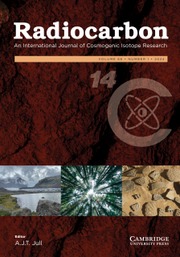Article contents
Balanced Window Method in 14C Liquid Scintillation Counting
Published online by Cambridge University Press: 18 July 2016
Abstract
The authors present a detailed theoretical and experimental study of the liquid scintillation balanced counting method, widely used in radiocarbon dating, using a simple, laboratory-made system. A fixed counting window becomes a balanced window when the high voltage is set where the 14C count rate rises to a maximum. Using a measured 14C pulse height spectrum, we have calculated the lower and upper limits for 11 balanced windows of varying width and their respective counting efficiencies. Furthermore, we have studied: (1) theoretically and experimentally, the counting efficiency for up to a ±15% shift in pulse height from the balanced setting, (2) the change in pulse height due to temperature variations, (3) the long-time stability of the system, and (4) a method that allows a quick determination of the balance voltage for individual samples, using the Compton spectrum of 133Ba. The standard deviation for thirty 24-hr measuring periods for a 14C standard (190 Bq) was within the expected statistical standard error (0.03%).
Information
- Type
- Notes & Comments
- Information
- Copyright
- Copyright © The Arizona Board of Regents on behalf of the University of Arizona
References
- 7
- Cited by

